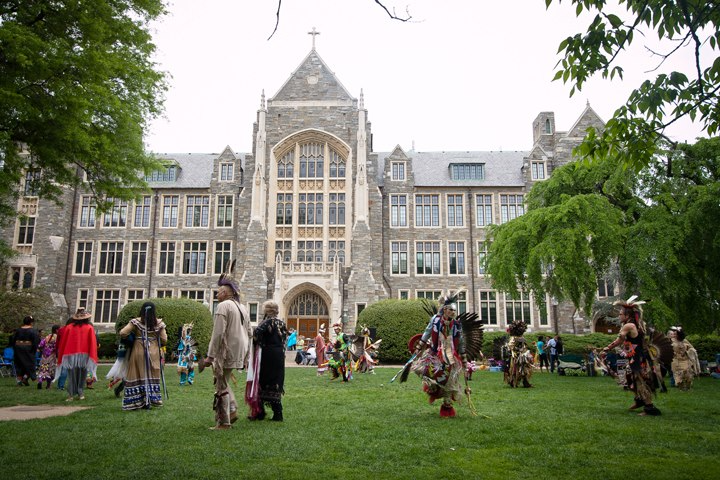The Georgetown University Student Association Senate unanimously passed a resolution demanding more university resources for Indigenous students at a meeting held April 11.
The resolution calls on the university to hire more Indigenous faculty, create an Indigenous studies major or minor and establish a designated space for Indigenous students to foster community, among other demands. GUSA Senate Speaker Melanie Cruz-Morales (COL ’22), who is an Indigenous student with past experience advocating for Indigenous rights and the Latinx community, wrote the resolution with her twin sister, GUSA Senator Sheila Cruz-Morales (COL ’22).

Indigenous students only make up approximately 0.1% of the Georgetown student body, reflecting the lack of academic and cultural resources given to Indigenous students by the university, according to Melanie Cruz-Morales.
“Looking at the Indigenous community, there’s absolutely nothing that they’re giving us — no type of guidance, no type of care for Indigenous students,” Melanie Cruz-Morales said in a phone interview with The Hoya.
GUSA has previously had a poor relationship with the Native American Student Council, a student group that advocates for the Indigenous community at Georgetown, due to what NASC perceived to be past performative statements by GUSA, according to Sheila Cruz-Morales.
As the only Indigenous members of the GUSA Senate, Sheila and Melanie Cruz-Morales felt compelled to pass a resolution that centered the voices of the Indigenous community at Georgetown, according to Sheila Cruz-Morales.
“We felt the responsibility to do something and speak up about it, despite GUSA having a previous shaky relationship with NASC and with doing a lot of performative work that talked about Indigenous students,” Sheila Cruz-Morales said in a phone interview with The Hoya.
NASC supports the resolution, which is similar to its own 2019 petition to the university to provide Indigenous students with more resources, according to a statement from NASC.
“This is the first step to address the crisis of apathy that Native students and communities experience on this campus daily,” the NASC wrote in an email to The Hoya. “We urge the University to collaborate with GUSA and NASC to obtain the full inclusion and respect that Indigenous students have always deserved.”
NASC’s petition proposed the creation of a Program Coordinator for Indigenous students and also called for a dedicated cultural sanctuary for Indigenous students, the establishment of a Native studies major or minor and demanded that the university hire more Indigenous faculty. As of now, the university has not officially responded to the petition.
In their resolution, Melanie and Sheila Cruz-Morales also aim to push the university to adopt policies that would make it eligible to partner with College Horizons, a program that supports Indigenous students in higher education. More than 40 universities have partnered with College Horizons, including Harvard University and Stanford University, to ensure that they meet the educational, financial and cultural needs of their Indigenous students.
While many other colleges have designated resources for their Indigenous students, Georgetown has yet to make significant strides toward fostering a more inclusive environment, according to Sheila Cruz-Morales.
“Even just for me and my sister, coming to this university has been difficult because of the lack of resources, the lack of space that there is for Indigenous students,” Sheila Cruz-Morales said. “If we want to bring more Indigenous students here, we have to make sure that this is a good, safe environment for Indigenous students to be in.”
Additionally, the creation of an Indigenous studies major or minor is crucial to support the Indigeous community, according to Melanie Cruz-Morales.
Georgetown currently has limited classes centered around Indigenous studies and only two Indigenous faculty members, which has created a lack of opportunity for Indigenous students to learn about their identity and has limited the worldview of non-Indigenous students, according to Melanie Cruz-Morales.
“Not only is that failing Indigenous communities in itself, but it is failing everyone because it is denying students the opportunity to learn about Indigenous people and the actual constant violence that Indigenous people face even in today’s age,” Melanie Cruz-Morales said.
GUSA has recently pushed for similar initiatives, such as the creation of a Latino studies minor program and the establishment of an Asian American studies program. Both of these initiatives, along with the push for an Indigenous studies program, have been brought up by various students and student groups over the past several years.
Georgetown University’s Indigenous Studies Working Group, which is composed of students, faculty and supporters from both the Georgetown community and the greater Washington, D.C. area, continues to provide resources to students and faculty interested in pursuing Indigenous histories, politics and cultures, according to a university spokesperson.
“The University is open to exploring programming, and course options that share our diversity, equity and inclusion values, and reflect the broad interests of our students,” the spokesperson wrote in an email to The Hoya.
The resolution also calls on Georgetown to acknowledge its occupation of Indigenous land. The university’s campus sits on land originally belonging to the Piscataway and the Nacotchtank, Indigenous tribes that held land in the Washington D.C. area in the 17th century. Some members of the Piscataway tribe still reside in the D.C. area today.
The university should work to establish a relationship with local tribal communities, many of which already have a relationship with NASC, according to Melanie Cruz-Morales.
“You see the relationship between the oppressor and the oppressed all the way back from the creation and establishment of Georgetown until today’s age, where Georgetown currently continues to sit on stolen land yet continues to deny accessibility to Indigenous students at its own institution,” Melanie Cruz-Morales said.
The university is open to working with local tribes in the D.C. area, according to the spokesperson.
“We deeply respect and are open to engaging with the Piscataway tribe, whose ancestral lands include the District of Columbia,” the spokesperson wrote.
Ultimately, Georgetown must acknowledge its past treatment toward Indigenous people and work to better support its Indigenous students, according to Sheila Cruz-Morales.
“Georgetown being a white elitist institution that has reaped the benefits of Indigenous lands and only continues to create more damage to Indigenous people, Indigenious students, as a whole,” Sheila Cruz-Morales said. “It is the school’s responsibility as Jesuits, as people with power, to really try to come to terms with their past and try to do better for the future.”





















